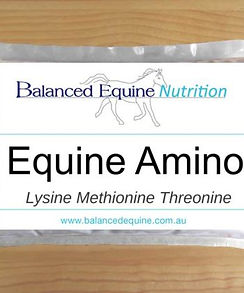Is Lucerne evil?
Some say Lucerne hay or chaff should never be fed as the protein is too high or too rich in ??? This is an example of looking at a feed ingredient or nutrient in isolation to the rest of the diet.
Somewhere, somone is saying that ‘x’ feed is evil and should never be fed and often it’s lucerne.
The answer is no, Lucerne is not evil but there are some horses that simply don’t agree with Lucerne and it shouldn’t be fed to these horses. Horses can have a feed intolerance to any feed including Lucerne. There are some horses (fortunately rare) that can’t tolerate certain species of grass. However it is wrong to say Lucerne shouldn’t be fed to any horses. Many horses do well on a small amount of Lucerne to boost calcium and protein. No feed ingredient or nutrient is bad per se, it depends on the situation and how much is fed. The whole diet needs to be looked at and keep it all in perspective.
It would be unwise to only feed Lucerne (also known as Alfalfa) as the majority forage, not just because protein would far exceed needs but the main issue is the calcium to phosphorus ratio and the calcium to magnesium ratio. If there is an excessive amount of calcium in the intake, it makes it impossible to add enough phosphorus and magnesium to correct the ratios, especially the phosphorus as it is particularly unpalatable and there are limited options for supplementing phosphorus without calcium. And calcium can inhibit the uptake of phosphorus, making the situation worse.
However, if the diet was poor in protein and calcium – and a horse only on Oaten hay or chaff would most likely be deficient in protein and calcium, then a small quantity of Lucerne is brilliant. Protein is the most expensive nutrient to supplement, I’d much rather solve a protein need with some Lucerne than the alternative of whey powder isolate, soy bean meal or some other expensive protein additive. That’s if the horse can tolerate Lucerne, in some cases horses are intolerant to Lucerne.
The better approach is to think about how much protein is needed by the horse and is it being met. For example, a 450 kg mature horse in work needs about 900 grams of protein per day including roughly 39 g lysine, the essential amino acid that has to come from the diet (data from 2007 Nutrient Requirements of Horses). The actual amount provided should exceed these amounts by a generous buffer but certainly not be less.
Out of more than 15000 samples (Dairy One lab) the average crude protein level of Oaten hay is 83 grams/kg. How much protein the horse is getting from the Oaten hay depends entirely on how much is eaten. If the horse was to eat 11 kg of hay (and the actual amount is anything like the average) then the horse would be getting protein needs satisfied but not by much (913 grams). If the intake was a smaller amount, say 8 kg then definitely a protein deficiency and for both amounts, essential amino acids like lysine, threonine and methionine will be too low. Balanced Equine Equine Amino can help. www.hvhoofandequinehealthcareproducts.com/product-page/balanced-equine-nutrition-equine-amino
A horse in work would most likely be receiving other feeds, if yes then the protein intake can be calculated by adding them all up. Hopefully this helps explain why focusing on one feed ingredient in isolation to the rest of the diet is rather unhelpful. And it matters with how much is actually fed – why % protein is silly too, something the feed manufacturers like to use for protein content. For example, 12% protein means 120 grams per kg fed. Actual protein intake depends entirely on how much is fed.
There are some insulin resistant/elevated insulin horses that can’t tolerate Lucerne and these horses should never be fed Lucerne. In this case, Lucerne for these horses is a risk factor for laminitis. It’s not the sugar + starch level as Lucerne is generally low but the amino acid profile may be the culprit.
Too much calcium in the diet from an intake where the forage is Lucerne could lead to:
-
Precipitation of calcium in the urine which could cause sediment or even stone formation. This is primarily a problem for geldings that have a narrow urethra.
-
Bone structure may be affected but we don't know the consequences in terms of bone strength.






